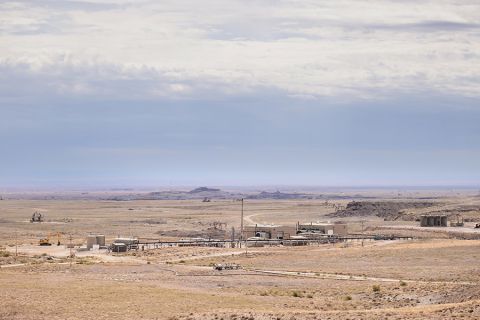It's not unusual to grow an oil field. Operators do it all the time. Typically a large oil field grows 145% over its original volume in the first seven years of its existence, according to Keith King, energy analyst with Exxon Mobil Corp.
Fields' tendency to grow over time forms the basis for developing scenarios for future growth, King said at an IHS regional conference in Houston. He was speaking only of conventional oil, not heavy, tar or shale oil.
Reserves typically are established early in the life of a field, but technology and investment can change volumes. He established the development scenarios by examining the IHS database, which didn't include onshore U.S. or onshore Canada.
Discoveries reach a big peak early and decline quickly if a person just looks at the superficial picture, but if a person adds the complete information about 16,000 fields, including increased field reserves, the picture is much less dismal.
The typical path for large fields should be an overall 2%-per-year production decline through a 70-year productive period with the size of the field more than doubling during that period. "If the trend to add 145% every seven years continues, we will add 1 trillion barrels of oil by 2076," he said. That assumes stable volumes of in-place oil and standard additional recoveries.
Improved and enhanced recovery techniques alone have added more than 1 trillion barrels of oil to international supplies since 1945, King said.
That amount of oil is equal to the total amount of oil consumed in the world to date. That improved recovery included pressure maintenance, but that is less and less of a factor now, since more fields factor pressure maintenance into initial reserve estimates.
Primary recovery can reach 40% of the oil in place. Secondary recovery can raise that number to 60% and enhanced oil recovery and future applications of technology can increase recoveries to 80% of the oil in place. Some heavy oil fields in California have improved on that figure.
The full application of improved oil recovery can add 200 billion barrels of oil. Some 40% of the world's producing oil fields are not under improved recovery now, he said.
Now, the average recovery rate from a field is 26%, but pressure maintenance alone should raise that figure to 34%.
Enhanced oil recovery includes miscible gas injection, carbon dioxide injection and steam injection. "Half of the world's oil has the characteristics acceptable for enhanced oil recovery," King said. Enhanced oil recovery is being applied now to only 11% of world oil, and another 40% of rock volume is amenable to enhanced recovery.
Extrapolating past trends show the world can add 1 trillion barrels of oil, he concluded. There is a catch: Both improved and enhanced recovery require a more comprehensive understanding and analysis of reservoirs. Oil companies must put in that work. Recovery of maximum volumes of oil also depends on political decisions made.
Recommended Reading
Baker Hughes Defies Nature with an Upgrade to Ol’ Fashioned Cement
2024-10-15 - Baker Hughes’ InvictaSet uses regenerative capabilities to provide operators with a sustainable cement solution that can last for years.
E&P Highlights: Nov. 4, 2024
2024-11-05 - Here’s a roundup of the latest E&P headlines, including a major development in Brazil coming online and a large contract in Saudi Arabia.
Navigating the Crossroads: Oil, Gas Industry Reimagines its Role in Tech Age
2024-10-28 - The oil and gas industry has both a need and an opportunity to embrace the digital transformation while engaging the next generation of its workforce.
E&P Highlights: Sept. 23, 2024
2024-09-23 - Here's a roundup of the latest E&P headlines, including Turkey receiving its first floating LNG platform and a partnership between SLB and Aramco.
Now, the Uinta: Drillers are Taking Utah’s Oily Stacked Pay Horizontal, at Last
2024-10-04 - Recently unconstrained by new rail capacity, operators are now putting laterals into the oily, western side of this long-producing basin that comes with little associated gas and little water, making it compete with the Permian Basin.
Comments
Add new comment
This conversation is moderated according to Hart Energy community rules. Please read the rules before joining the discussion. If you’re experiencing any technical problems, please contact our customer care team.





